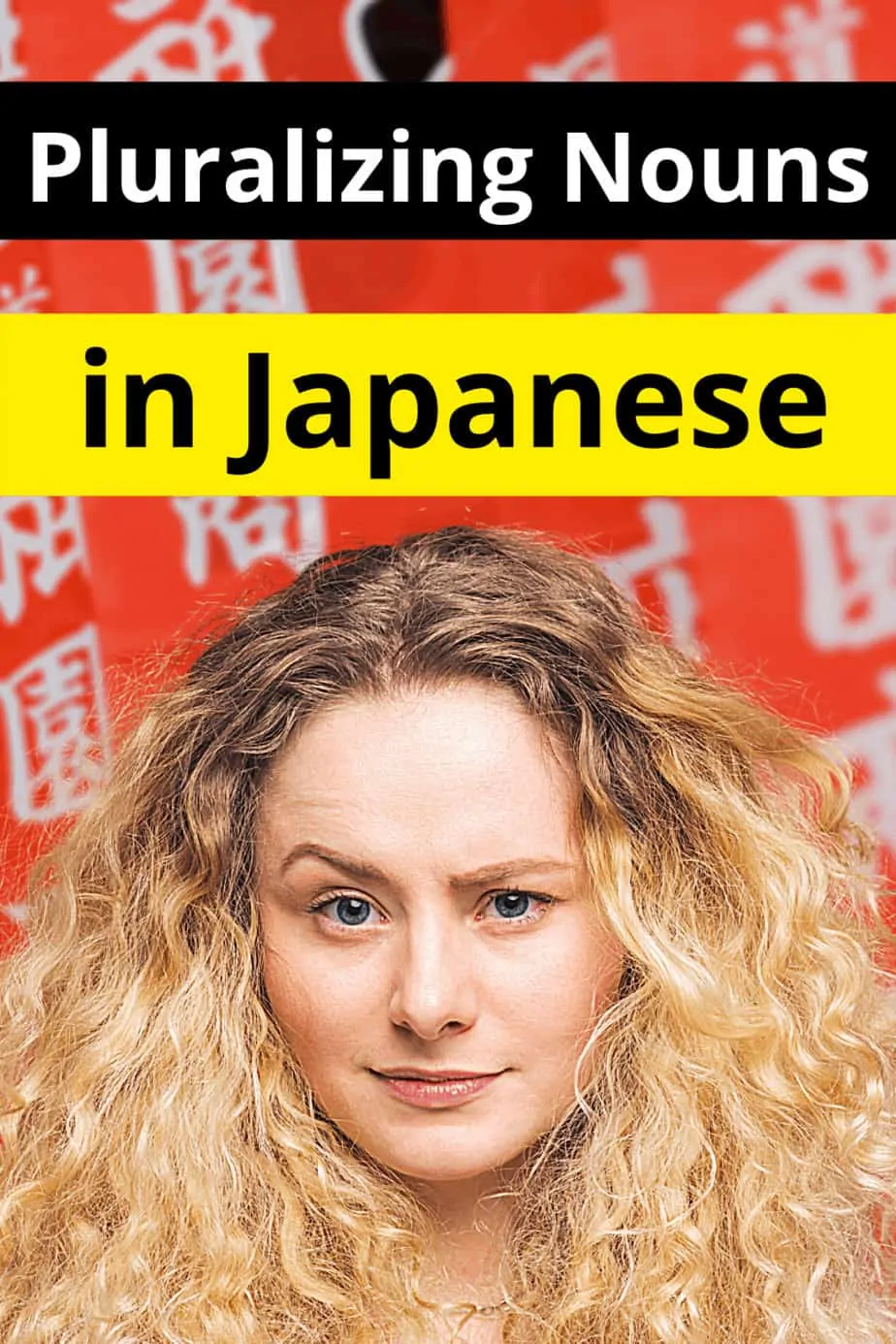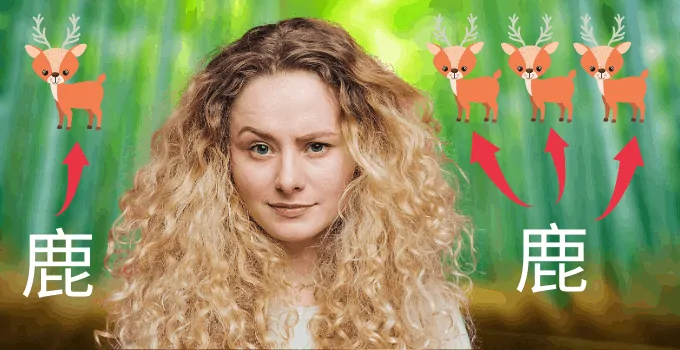One aspect of Japanese that often causes difficulty for translators and students alike is how the language handles plural.
You might have heard that there’s no plural at all in Japanese. While that’s not strictly true, for the most part it’s accurate.
That means that, when translating into English or even understanding something in Japanese, you need to use context to make sure if something is singular or plural.
Let’s take a more thorough look at how pluralization works in Japanese.
How do you make nouns plural in Japanese?
The plural form of a noun in Japanese is identical to its singular form. For example, the word 鹿 (shika, “deer”) could refer to one or several deer, just like the English word “deer.” There are several strategies you can use to make it clear when something is plural, including the use of counter words, the use of quantity words like 全て (subete, “all”) or 数 (suu, “several”) and the use of たち (tachi, the pluralization marker) for people. By itself, though, there’s no way to tell if a particular noun is singular or plural.
Japanese nouns: singular and plural
Grammatically speaking, Japanese nouns have no grammatical number.
In plain English, what that means is that the singular form and the plural form are the same for all nouns.
If you see えんぴつ (enpitsu, “pencil”), that could mean a single pencil or it could mean multiple pencils.
On the one hand, this is great. You don’t need to memorize multiple versions of the same word, or esoteric patterns to pluralize a word.
If you want to make a noun plural, you… just use the noun, the same way you would if it were singular. Woohoo!
On the other hand, though, Japan’s lack of a grammatical number can be confusing.
Let’s take a short digression and do a deeper dive to see why this makes translation, or just understanding, complicated.
After that, we’ll look at some solutions for explicitly pluralizing Japanese words.
The case of the jumping frog(s)
古池や
蛙飛びこむ
水の音
This example is a famous haiku (a type of short poem), written by Matsuo Bashō in the late 1600s.
That might seem a bit strange, but bear with me a minute!
The typical translation of the haiku into English goes something like this:
old pond…
a frog jumps in
the sound of water
However, there’s actually nothing in this haiku which makes 蛙 (kawazu, “frog”) explicitly single. As mentioned, nouns in Japanese can be either singular or plural, depending on their context.
In this case, there isn’t a lot of context in the poem itself, but this essay from the New Zealand Poetry Society argues that there are good reasons for a translation where “frog” is plural:
The old pond…
frogs jumping in
the sound of water
You might think this is just a problem of translation, but it’s not. Even in Japanese, it’s an open question whether there are multiple frogs in this haiku, or just one frog.
This essay from professor Tojo Toshiki at Notre Dame Seishin University discusses several possibilities before ending with the admission that it’s impossible to tell.
It might seem like the number of frogs in a 400-year-old haiku is meaningless today, but the lack of pluralization in Japanese can cause misunderstandings in the modern world as well.
For example, what if your new boss asks you to fetch「あの新入」(ano shinnyuu, “that newcomer”)?
Are they asking you to get a single person, or are they asking you to go gather all the new hires?
Let’s look at a few options for adding clarity when it’s important.

Meet たち (tachi) and ら (ra), the “group” suffixes
The suffixes たち (tachi) and ら (ra) can be added to the end of a person or pronoun to refer to multiple people.
The main difference between the two is that たち sounds slightly more polite, and ら slightly more casual.
These suffixes don’t technically make things plural, but are what grammarians call “collectivizing suffixes.”
In other words, saying ジョンたち doesn’t mean “the Johns,” but rather “John and the other people with John.”
Additionally, these suffixes can only be used with people. In some cases, you can also use it for animals, but it sounds very cutesy and isn’t appropriate unless you are talking to a very small child or want to sound like you are yourself a small child. (We won’t judge you.)
It’s important to make sure you don’t use these suffixes for inanimate objects, in any case.
If you walk around talking about your えんぴつたち (enpitsu, “pencil” + tachi) or ask about the 車ら (kuruma, “car” + ra), people are going to think you either failed your Japanese class or are mighty strange.
Examples
Both of these examples use たち and ら as a suffix to “collectivize” the noun for “that kid” (あの子) and I (おれ), respectively.
This is similar to our hypothetical example from the first section of the article. Here, it’s clear that your boss is asking you to tell all the new hires about something.
Of course, if that was already clear from context, for instance if you were talking about possible changes to scheduling that would have far-reaching consequences, this could imply a plural even without たち.
This could, however, also mean “the new hire,” so if you absolutely need to imply a group of people たち and ら are very useful suffixes.
Counter words: a solution with its own problem
Because たち and ら can only be used with people, other strategies are needed when dealing with animals or inanimate objects.
One option for pluralizing nouns is to use counter words. These words can be combined with numbers to refer to a specific amount of nouns of the same type.
This is similar to English, where you could say “There are four deer” and be a lot more specific than “There are deer.”
To do this in Japanese, you use the following structure:
[noun] は [number] [counter] が [be verb]
You can also use counters with other verbs if the thing being counted is a direct object:
[noun] を [number] [counter] [verb]
So,「鹿は四匹います。」would be “there are four deer.” (Remember that you need to use います (imasu) for living things and あります (arimasu) for inanimate objects.)
Unfortunately, counter words come with their own wrinkle: there are a lot of them, and the word you need to use varies depending on the noun you’re describing.
In some cases, the set of nouns that can be described with a counter word makes sense.
For instance, 匹 (hiki) is used for ‘small’ animals like dogs, cats or deer.
Others seem strange to non-native speakers, such as 個 (ko) for small, round objects.
Yet others, such as 丁 (chou), come with seemingly impossible lists to memorize. 丁, for instance, is used for “Sheets, pages, leaves, tools, scissors, saws, trousers, pistols, cakes of tofu, town blocks and servings at a restaurant,” according to Wikipedia.
It would take a long time to go into exhaustive detail on all the possible counter words in Japanese, but fortunately you don’t need to know many (if you want to really go wild, check out this counting dictionary.)
Let’s take a short while and look at the most common counters.
つ (tsu) as “things”
つ (tsu) is kind of a catch-all counter, and is also used in the traditional Japanese counting system.
As a counter word, it basically means “things.”
That said, if another counter word like 本 or 匹 is more appropriate, you should use that instead.
Examples
Counters for animals
匹 (hiki) is the counter used for many kinds of small to medium-sized animals, as well as most types of fish, insects and reptiles.
Birds and rabbits get another counter, 羽 (wa), while large animals use the counter 頭 (tou). Weirdly, dolphins and butterflies are also counted with 頭.
Examples
This Japanese sentence is also a classic tongue-twister. It’s pronounced “niwa ni wa niwatori ga niwa arimasu.” (Check out the harder version.)
人 (ri, nin), the counter for people
This counter is one that is learned pretty early in many Japanese classes as the words 一人 (hitori, “one person” or “alone”) and 二人 (futari, “two people” or “together).
It can also be used with larger numbers of people, and sometimes is read as “nin” instead of “ri.”
Examples
本 (hon, pon, bon), the counter for things that are long and thin
本 is used to count anything that’s long and thin and for a few other odds and ends.
Pencils, bottles and rivers all use this counter, as do telephone calls, individual chopsticks and train routes.
Examples
個 (ko) for small round objects
If you’re counting grains of sand on a beach, you might need a new hobby.
You also might need the counter 個 (ko), which is used to count anything small and round. It’s used for military divisions like brigades or armies too, oddly enough.
Other common counters
枚 (mai) is used for sheets of paper and other thin, flat things, while the counters 度 (do) and 回 (kai) can both be used to count occurrences of something.
Quantifying your nouns with other words
Another problem with counters is that they only work if you’re dealing with specific numbers.
What if you really just want to say there is some number of deer outside, for instance?
If you want to pluralize something without numbers, you can use a quantity word like “several” or “all” in place of the number and counter word from our previous sentence structures.
[noun] は [quantity word] が [be verb]
[noun] を [quantity word] [verb]
Note that, in some cases, you actually will still need a counter word with a quantity word.
数 (suu, “several”), for example, requires a counter after it just like a number.
You can also use 何 (nani, “what”) with a counter to ask how many of something there are.
Other words, such as 皆 (minna, “all”) or 全部 (zenbu, “all”) don’t require counters, although some quantity words such as 複数 (fukusuu, “several”) do use a different type of sentence structure.
There isn’t really a shortcut to learning which is which, unfortunately.
Just keep an ear out as you listen to Japanese conversations and you’ll gradually build up your confidence and awareness of which structure is the most appropriate one.
Examples
This sentence is very explicitly referring to more than one deer, thanks to 皆 (minna, “all”).
As noted, 複数 uses a different sentence structure, and precedes the noun it quantifies, rather than following it.
When in doubt, leave it out
Learning all these complicated rules for making nouns plural can be a challenge.
You can do it if you put your mind to it, but sometimes you just want to take the easy option.
In that case, always remember how this article started: there is literally no difference between singular and plural nouns in Japanese.
That means it’s perfectly acceptable (and considerably easier) to simply use a noun to refer to a nonspecific number of something, as well as to mean a single one of it.
Unless you really need the specificity of a specific number plus a counter, it might be best to stick to the noun by itself that when you need a plural noun.

Hey fellow Linguaholics! It’s me, Marcel. I am the proud owner of linguaholic.com. Languages have always been my passion and I have studied Linguistics, Computational Linguistics and Sinology at the University of Zurich. It is my utmost pleasure to share with all of you guys what I know about languages and linguistics in general.

